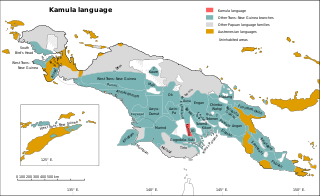Related Research Articles
The East Papuan languages is a defunct proposal for a family of Papuan languages spoken on the islands to the east of New Guinea, including New Britain, New Ireland, Bougainville, Solomon Islands, and the Santa Cruz Islands. There is no evidence that these languages are related to each other, and the Santa Cruz languages are no longer recognized as Papuan.
Abau is a Papuan language spoken in southern Sandaun Province of Papua New Guinea, primarily along the border with Indonesia.
Kuman is a language of Chimbu Province, Papua New Guinea. In 1994, it was estimated that 80,000 people spoke Kuman, 10,000 of them monolinguals; in the 2000 census, 115,000 were reported, with few monolinguals. Ethnologue also reported 70,000 second language speakers in 2021.
The Senagi languages are a small family of Papuan languages in the classification of Malcolm Ross, that had been part of Stephen Wurm's Trans–New Guinea proposal. They consist of the two languages Angor and Dera.
The Yuat languages are an independent family of five Papuan languages spoken along the Yuat River in East Sepik Province, Papua New Guinea. They are an independent family in the classification of Malcolm Ross, but are included in Stephen Wurm's Sepik–Ramu proposal. However, Foley and Ross could find no lexical or morphological evidence that they are related to the Sepik or Ramu languages.
The Yalë language, also known as Yadë, Nagatman, or Nagatiman, is spoken in northwestern Papua New Guinea. It may be related to the Kwomtari languages, but Palmer (2018) classifies it as a language isolate.
The Ata language, also known as Pele-Ata after its two dialects, or Wasi, is a Papuan language spoken on New Britain island, Papua New Guinea. It appears to be related to neighboring Anêm, and possibly also to Yélî Dnye in a proposed Yele-West New Britain family. There are about 2000 speakers.

Papua New Guinea, a sovereign state in Oceania, is the most linguistically diverse country in the world. According to Ethnologue, there are 839 living languages spoken in the country. In 2006, Papua New Guinea Prime Minister Sir Michael Somare stated that "Papua New Guinea has 832 living languages ." Languages with statutory recognition are Tok Pisin, English, Hiri Motu, and Papua New Guinean Sign Language. Tok Pisin, an English-based creole, is the most widely spoken, serving as the country's lingua franca. Papua New Guinean Sign Language became the fourth officially recognised language in May 2015, and is used by the deaf population throughout the country.

The Angan or Kratke Range languages are a family of the Trans–New Guinea languages in the classification of Malcolm Ross. The Angan languages are clearly valid as a family. They were first identified as such by J. Lloyd and A. Healey in 1968; Wurm (1975) classified them as Trans–New Guinea. Glottolog treats Angan as a separate or unclassified family, ignoring further evidence.
The Kwalean or Humene–Uare languages are a small family of Trans–New Guinea languages spoken in the "Bird's Tail" of New Guinea. They are classified within the Southeast Papuan branch of Trans–New Guinea.
Pyu is a language isolate spoken in Papua New Guinea. As of 2000, the language had about 100 speakers. It is spoken in Biake No. 2 village of Biake ward, Green River Rural LLG in Sandaun Province.
Pomio District is a district of East New Britain Province in Papua New Guinea. It is one of the four administrative districts that make up the province.
Kapori (Kapauri) is a Papuan language of Pagai village in Airu District, Jayapura Regency, Papua, Indonesia.

Kamula is a Trans–New Guinea language that is unclassified within that family in the classification of Malcolm Ross (2005). Noting insufficient evidence, Pawley and Hammarström (2018) leave it as unclassified.
Kwomtari is the eponymous language of the Kwomtari family of Papua New Guinea.

Tabo, also known as Waia (Waya), is a Papuan language of Western Province, Papua New Guinea, just north of the Fly River delta. The language has also been known as Hiwi and Hibaradai.
Mufian, or Southern Arapesh, is an Arapesh language (Torricelli) of Papua New Guinea. Dialects are Supari, Balif, Filifita (Ilahita), Iwam-Nagalemb, Nagipaem; Filifita speakers are half the population, at 6,000 in 1999. It is spoken in 36 villages, most of which are located within Bumbita-Muhian Rural LLG, East Sepik Province. It is also spoken in Supari ward of Albiges-Mablep Rural LLG.
Kire (Giri) is a Ramu language of Giri village in Yawar Rural LLG, Madang Province, Papua New Guinea.
Sepik Iwam, or Yawenian, is a language of Papua New Guinea. It is the lexical basis of the Hauna trade pidgin.
Tumleo is an Austronesian language of coastal Sandaun Province, Papua New Guinea, on Tumleo Island and the Aitape coast in East Aitape Rural LLG.
References
- ↑ Kol at Ethnologue (18th ed., 2015) (subscription required)
- ↑ Eberhard, David M.; Simons, Gary F.; Fennig, Charles D., eds. (2019). "Papua New Guinea languages". Ethnologue: Languages of the World (22nd ed.). Dallas: SIL International.
- ↑ Dunn, Michael; Reesnik, Ger; Terrill, Angela (2002). "The East Papuan Languages: A Preliminary Typological Appraisal" (PDF). Oceanic Linguistics. 41 (1): 28–62. doi:10.1353/ol.2002.0019. hdl: 11858/00-001M-0000-0013-1ADC-1 . S2CID 143012930 . Retrieved 6 February 2021.
- ↑ Lindrud, Stellan (October 1992). Kol Language [KOL] East New Britain Province (PDF). Organised Phonology Data: SIL.
- ↑ Greenhill, Simon (2016). "TransNewGuinea.org - database of the languages of New Guinea" . Retrieved 2020-11-05.